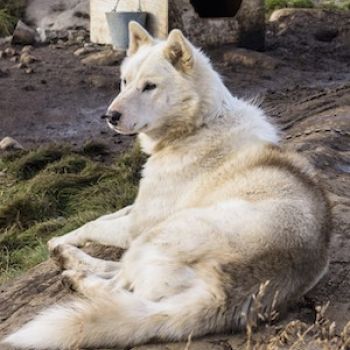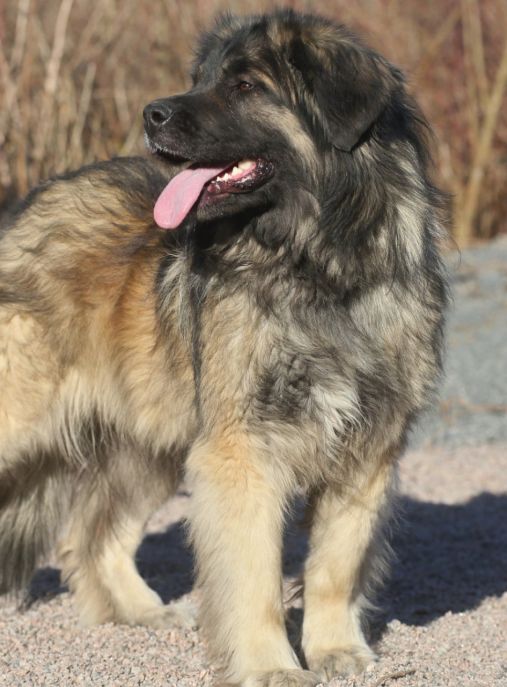The Greenland Dog, also known as the Greenland Husky, is a powerful and robust breed that hails from the Arctic region. These dogs are well-adapted to the harsh and unforgiving climate of Greenland, where they have been used for centuries as sled dogs and hunting companions. With their striking appearance and incredible endurance, the Greenland Dog is a breed that commands attention and respect.
In terms of its history, the Greenland Dog can trace its roots back to the ancient Arctic sled dogs that were brought to Greenland by the Thule people around 4,000 years ago. These dogs were crucial to the survival of the Inuit people, as they were used for transportation, hunting, and even as a source of food and clothing. Over time, the Greenland Dog developed into a distinct breed, well-suited to the demanding conditions of the Arctic.
According to the FCI (Fédération Cynologique Internationale) typology, the Greenland Dog falls under Group 5, which includes the Spitz and primitive types. This group consists of dogs that share common characteristics such as a thick double coat, erect ears, and a curled tail. The Greenland Dog is also classified as a Nordic breed, along with other sled dog breeds like the Alaskan Malamute and the Siberian Husky.
The Greenland Dog is primarily bred for working purposes, particularly as a sled dog. Its strong build, endurance, and ability to withstand extreme cold make it an ideal choice for pulling heavy loads over long distances. These dogs have an innate sense of direction and are known for their navigational skills, which are crucial in the vast and treacherous Arctic landscape. In addition to their working abilities, Greenland Dogs also make loyal and affectionate companions for those who can provide them with the exercise and mental stimulation they require.
In terms of physical characteristics, the Greenland Dog is a large and muscular breed. Males typically weigh between 66-100 pounds (30-45 kg), while females are slightly smaller, weighing between 49-84 pounds (22-38 kg). They have a well-developed chest, strong legs, and a deep, broad muzzle. The breed's thick double coat, consisting of a dense undercoat and a longer, coarse outer coat, provides excellent insulation against the cold. The coat comes in various colors, including black, white, gray, and piebald.
The average height of a Greenland Dog ranges from 20-24 inches (51-61 cm) at the shoulder. They have a sturdy build and a strong bone structure, which enables them to pull heavy loads with ease. The breed has a life expectancy of around 12-14 years, although with proper care and nutrition, some Greenland Dogs have been known to live even longer.
One interesting fact about the Greenland Dog is its ability to adapt to extreme weather conditions. These dogs have a thick layer of blubber beneath their skin, which helps to insulate them against the cold. Additionally, their paws are well-suited to walking on snow and ice, with thick pads that provide traction and prevent slipping. Their almond-shaped eyes are protected by a layer of fat, which shields them from the harsh glare of the sun on the snow.
Another notable characteristic of the Greenland Dog is its strong prey drive. These dogs have a natural instinct to hunt, which can make them challenging to train and control. Early socialization and consistent, positive reinforcement training methods are essential to ensure that they develop into well-behaved and obedient companions.
In conclusion, the Greenland Dog is a remarkable breed with a rich history and impressive working abilities. Their strength, endurance, and adaptability to extreme weather conditions make them well-suited to life in the Arctic. While they may not be suitable for every owner due to their high energy levels and strong prey drive, those who can provide them with the exercise and mental stimulation they need will be rewarded with a loyal and devoted companion.
The Greenland Dog, also known as the Greenland Husky, is a remarkable breed with a rich history and a unique character. These dogs have been an integral part of Greenlandic culture for centuries, serving as sled dogs and companions to the indigenous people of the Arctic. Their character is shaped by their environment and purpose, making them highly adaptable, intelligent, and loyal companions.
In terms of behavior, Greenland Dogs are known for their friendly and gentle nature. They are generally good-natured and get along well with people, including children. However, due to their strong prey drive and working instincts, they may not be the best fit for households with small pets such as cats or rabbits. Early socialization is crucial to ensure they grow up to be well-rounded dogs.
Being a working breed, Greenland Dogs have a high energy level and require plenty of exercise. They thrive in an active environment where they can engage in activities that stimulate their mind and body. Regular long walks, jogs, or hikes are essential to keep them physically and mentally stimulated. These dogs have a strong desire to pull and are well-suited for dog sports like mushing or skijoring.
Training a Greenland Dog requires patience, consistency, and positive reinforcement. They are intelligent and eager to please, but they can also be independent and stubborn at times. Early obedience training and socialization are essential to establish a strong foundation. Positive reinforcement techniques, such as treats, praise, and play, work best with this breed. Harsh training methods should be avoided as they can lead to fear or aggression.
Greenland Dogs are pack animals and thrive in a family environment. They form strong bonds with their human family and are known for their loyalty and protectiveness. However, they may be reserved or aloof with strangers, which makes them excellent watchdogs. Early socialization can help them differentiate between genuine threats and harmless strangers.
When it comes to raising a Greenland Dog, it is important to provide them with a consistent routine and clear boundaries. They are intelligent dogs that thrive on structure and predictability. A well-balanced diet, regular veterinary care, and grooming are essential for their overall health and well-being.
Due to their thick double coat, Greenland Dogs are well-suited for cold climates. They have a dense undercoat that keeps them warm in freezing temperatures. Regular brushing is necessary to prevent matting and to keep their coat healthy. During shedding seasons, they require more frequent brushing to manage the shedding.
In conclusion, the Greenland Dog is a remarkable breed with a unique character shaped by their working heritage. They are friendly, intelligent, and loyal companions that require plenty of exercise and mental stimulation. With proper training, socialization, and care, they can make wonderful additions to active families who can provide them with the attention and exercise they need.
The Greenland Dog, also known as the Greenland Husky, is a powerful and hardworking breed that originates from Greenland. These dogs were traditionally used for pulling sleds and hunting in the Arctic regions. Caring for a Greenland Dog requires special attention and understanding of their unique needs. Here are some tips on how to properly care for dogs of this breed, including what to do and what not to do.
1. Exercise: Greenland Dogs are highly active and energetic. They require regular exercise to keep them physically and mentally stimulated. Daily walks, jogs, or play sessions in a secure and spacious area are essential. Avoid off-leash activities in unsecured areas as these dogs have a strong prey drive and may chase small animals.
2. Grooming: Greenland Dogs have a thick double coat that helps them withstand harsh Arctic conditions. Regular brushing is necessary to prevent matting and remove loose fur. During shedding seasons, which occur twice a year, more frequent brushing is required. However, avoid excessive bathing as it can strip their coat of natural oils.
3. Feeding: Provide a well-balanced diet that meets the nutritional needs of a working breed. Consult with a veterinarian to determine the appropriate amount and type of food for your dog. Avoid overfeeding, as Greenland Dogs have a tendency to gain weight if not properly exercised.
4. Socialization: Early socialization is crucial for Greenland Dogs to develop good behavior and adaptability. Expose them to various environments, people, and other animals from a young age. This will help prevent aggression or fearfulness towards unfamiliar situations.
5. Training: Greenland Dogs are intelligent but can be independent and stubborn. Consistent and positive reinforcement training methods work best with this breed. Use rewards, such as treats or praise, to motivate and encourage good behavior. Avoid harsh training techniques as they can lead to fear or aggression.
6. Temperature regulation: Greenland Dogs have a thick coat that provides insulation in cold climates. However, they may struggle in warmer environments. Ensure they have access to shade, fresh water, and a cool area during hot weather. Avoid leaving them in hot cars or exposing them to excessive heat.
7. Health care: Regular veterinary check-ups are essential to monitor the overall health of your Greenland Dog. Vaccinations, parasite prevention, and dental care should be maintained. Additionally, be aware of breed-specific health issues such as hip dysplasia, eye problems, and gastric torsion (bloat). Regular exercise and a balanced diet can help prevent obesity, which can exacerbate these conditions.
8. Mental stimulation: Greenland Dogs are intelligent and require mental stimulation to prevent boredom and destructive behavior. Provide puzzle toys, interactive games, and training sessions to keep their minds engaged. Engaging in activities that mimic their working heritage, such as pulling a sled or participating in dog sports, can also be beneficial.
What not to do:
1. Do not leave a Greenland Dog alone for extended periods. They are social animals and thrive on companionship. Leaving them alone for too long can lead to separation anxiety and destructive behavior.
2. Do not use harsh or punitive training methods. Greenland Dogs respond best to positive reinforcement and gentle guidance. Harsh training techniques can damage the bond between you and your dog.
3. Do not neglect their exercise needs. Insufficient exercise can lead to behavioral problems and obesity. Ensure they have enough physical activity to keep them happy and healthy.
4. Do not shave their coat. The thick double coat of a Greenland Dog provides insulation in both cold and warm weather. Shaving their coat can disrupt their natural temperature regulation and expose them to sunburn or cold-related issues.
5. Do not ignore their mental stimulation needs. Boredom can lead to destructive behavior or excessive barking. Provide them with mental challenges and activities to keep their minds occupied.
Caring for a Greenland Dog requires commitment, patience, and understanding of their unique needs. By following these tips and providing them with proper care, you can ensure a happy and healthy life for your beloved Greenland Dog.
The Greenland Dog, also known as the Greenland Husky, is a majestic and powerful breed that hails from the Arctic regions. These dogs possess a distinctive and captivating coat that adds to their overall allure. When it comes to their common color, the Greenland Dog showcases a range of shades that are reminiscent of the breathtaking landscapes of Greenland.
The most prevalent color seen in Greenland Dogs is a striking and eye-catching combination of white and various shades of gray. The base color of their coat is typically a pure, pristine white, which serves as a canvas for the intricate patterns and markings that adorn their fur. This white hue symbolizes the vast snow-covered landscapes that these dogs have adapted to over centuries.
Intermingled with the white, the Greenland Dog's coat often displays shades of gray that can vary in intensity and depth. These shades of gray can range from a light, silvery tone to a darker, charcoal-like hue. The gray tones are usually distributed in patches or streaks across the dog's body, creating a visually appealing contrast against the white backdrop.
In addition to the white and gray combination, some Greenland Dogs may also exhibit hints of other colors in their coat. It is not uncommon to find dogs with subtle tinges of cream, beige, or even light brown in their fur. These additional colors add a touch of warmth and diversity to their overall appearance, further enhancing their unique charm.
The coat of a Greenland Dog is not only visually captivating but also serves a practical purpose in their Arctic habitat. The thick double coat provides insulation and protection against the harsh cold climate, allowing them to thrive in freezing temperatures. The outer coat is composed of long, coarse guard hairs that repel moisture and prevent snow from sticking to their bodies. Underneath this outer layer lies a dense and soft undercoat that provides additional insulation.
It is important to note that while the common color of Greenland Dogs is predominantly white and gray, individual variations can occur. Some dogs may have more pronounced gray markings, while others may exhibit a predominantly white coat with only subtle hints of gray. Each dog's unique coloration adds to the overall diversity and beauty of this remarkable breed.
In conclusion, the common color of Greenland Dogs is a captivating combination of white and various shades of gray. This color scheme, reminiscent of the Arctic landscapes they call home, showcases the breed's adaptability and resilience. Whether they are pulling sleds through the snow or simply being a loyal companion, the Greenland Dog's coat color is a testament to their remarkable heritage and natural beauty.
The Greenland Dog, also known as the Greenland Husky, is a robust and hardy breed that originated in Greenland. These dogs were traditionally used for pulling sleds and hunting in the Arctic regions. With their thick double coat, strong build, and endurance, they are well-suited to withstand the harsh Arctic climate. When it comes to their health, Greenland Dogs are generally a healthy breed, but like any other dog, they can be prone to certain diseases and require proper care to maintain their well-being.
One of the most common health issues seen in Greenland Dogs is hip dysplasia. This is a genetic condition where the hip joint doesn't develop properly, leading to pain, lameness, and arthritis. Regular exercise, a balanced diet, and maintaining a healthy weight can help reduce the risk of hip dysplasia. Responsible breeders often screen their breeding dogs for this condition to minimize its occurrence in the breed.
Another common health concern in Greenland Dogs is progressive retinal atrophy (PRA). PRA is a group of genetic eye disorders that gradually lead to vision loss and, in severe cases, blindness. Regular eye examinations by a veterinary ophthalmologist can help detect PRA early on, allowing for appropriate management and care.
Like many large breeds, Greenland Dogs can also be prone to gastric dilatation-volvulus (GDV), commonly known as bloat. This is a life-threatening condition where the stomach twists, trapping gas and causing a rapid expansion. GDV requires immediate veterinary attention and can be prevented by feeding multiple small meals throughout the day, avoiding exercise immediately after meals, and using elevated feeding bowls.
Maintaining good oral hygiene is crucial for Greenland Dogs, as they are prone to dental issues like periodontal disease. Regular brushing of their teeth, providing dental chews, and scheduling professional dental cleanings can help prevent dental problems and maintain overall oral health.
Proper nutrition is essential for the health of Greenland Dogs. A high-quality diet that meets their nutritional needs, including a balance of proteins, fats, carbohydrates, vitamins, and minerals, is crucial. Feeding a diet appropriate for their age, size, and activity level can help prevent obesity and related health issues.
Exercise is vital for Greenland Dogs to keep them physically and mentally stimulated. They have a high energy level and require regular exercise to prevent boredom and destructive behavior. Daily walks, jogs, or engaging in activities like sledding or agility training can help meet their exercise needs.
Regular veterinary check-ups are essential for monitoring the overall health of Greenland Dogs. Vaccinations, parasite prevention, and routine blood tests are part of preventive care. Additionally, maintaining a clean and safe environment, providing fresh water, and ensuring proper grooming, including regular brushing and nail trimming, are important aspects of their care.
In conclusion, Greenland Dogs are generally a healthy breed, but they can be prone to certain conditions like hip dysplasia, PRA, bloat, and dental issues. Responsible breeding practices, regular veterinary care, a balanced diet, proper exercise, and good oral hygiene are key to maintaining the health and well-being of these magnificent Arctic dogs.
The Greenland Dog, also known as the Greenland Husky or the Greenland Eskimo Dog, is a robust and hardworking breed that originated in Greenland. These dogs have been used for centuries by the Inuit people for various tasks, including pulling sleds and hunting. To ensure the optimal health and well-being of Greenland Dogs, it is crucial to provide them with a balanced and nutritious diet.
When it comes to feeding Greenland Dogs, it is important to consider their high energy levels and their working dog heritage. These dogs require a diet that is rich in protein, as it helps support their muscle development and overall energy levels. High-quality sources of protein, such as lean meats like chicken, turkey, and fish, should be the foundation of their diet.
In addition to protein, Greenland Dogs also require a moderate amount of fat in their diet. Fat serves as a concentrated source of energy and helps maintain healthy skin and coat. Including healthy fats from sources like fish oil, flaxseed oil, or coconut oil can be beneficial for their overall health.
Carbohydrates are another essential component of a Greenland Dog's diet. However, it is important to choose complex carbohydrates that provide sustained energy rather than simple sugars. Whole grains like brown rice, oats, and quinoa are excellent choices. These carbohydrates also provide essential fiber, aiding in digestion and maintaining a healthy weight.
Greenland Dogs are prone to certain health issues, so it is crucial to avoid certain foods that may exacerbate these conditions. For instance, they can be prone to hip dysplasia, so it is important to avoid excessive calcium intake during their growth phase. Additionally, they may have sensitivities or allergies to certain ingredients, so it is essential to monitor their reactions to different foods and consult with a veterinarian if any issues arise.
Feeding Greenland Dogs should be done in appropriate portions to prevent obesity. These dogs have a strong appetite and can easily overeat if not monitored. It is recommended to divide their daily food intake into two or three meals to prevent bloating and other digestive issues.
Freshwater should always be available to Greenland Dogs, especially during periods of increased physical activity or warmer weather. Hydration is crucial for their overall health and well-being.
Supplements can also be beneficial for Greenland Dogs, especially those that are working or highly active. Omega-3 fatty acids, glucosamine, and chondroitin are commonly recommended to support joint health and mobility.
In conclusion, feeding a Greenland Dog requires a balanced and nutritious diet that meets their high energy requirements. A diet rich in high-quality protein, moderate in fat, and with complex carbohydrates is ideal. Avoiding certain foods that may exacerbate health issues and monitoring portion sizes are also important. By providing proper nutrition, you can help ensure the health and longevity of your Greenland Dog.






